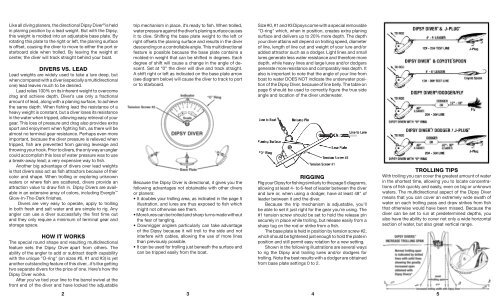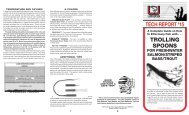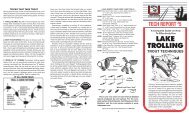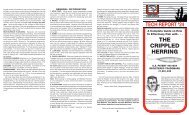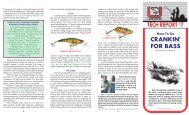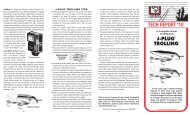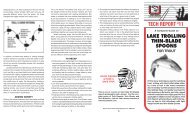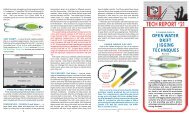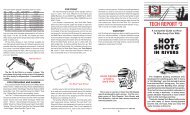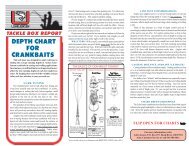Dipsy Diver Depth Chart and Information - UPangler
Dipsy Diver Depth Chart and Information - UPangler
Dipsy Diver Depth Chart and Information - UPangler
Create successful ePaper yourself
Turn your PDF publications into a flip-book with our unique Google optimized e-Paper software.
Like all diving planers, the directional <strong>Dipsy</strong> <strong>Diver</strong> ® is held<br />
in planing position by a lead weight. But with the <strong>Dipsy</strong>,<br />
this weight is molded into an adjustable base plate. By<br />
rotating this plate to the right or left, the planing surface<br />
is offset, causing the diver to move to either the port or<br />
starboard side when trolled. By leaving the weight at<br />
center, the diver will track straight behind your boat.<br />
DIVERS VS. LEAD<br />
Lead weights are widely used to take a lure deep, but<br />
when compared with a diver (especially a multidirectional<br />
one) lead leaves much to be desired.<br />
Lead relies 100% on its inherent weight to overcome<br />
drag <strong>and</strong> achieve depth. <strong>Diver</strong>’s use only a fractional<br />
amount of lead, along with a planing surface, to achieve<br />
the same depth. When fishing lead the resistance of a<br />
heavy weight is constant, but a diver loses its resistance<br />
in the water when tripped, allowing easy retrieval of your<br />
gear. This loss of pressure <strong>and</strong> drag also provides extra<br />
sport <strong>and</strong> enjoyment when fighting fish, as there will be<br />
almost no terminal gear resistance. Perhaps even more<br />
important, because the diver pressure is relieved when<br />
tripped, fish are prevented from gaining leverage <strong>and</strong><br />
throwing your hook. Prior to divers, the only way an angler<br />
could accomplish this loss of water pressure was to use<br />
a break-away lead; a very expensive way to fish.<br />
Another big advantage of divers over lead weights<br />
is that divers also act as fish attractors because of their<br />
color <strong>and</strong> shape. When trolling or exploring unknown<br />
waters or where fish are scattered, divers provide an<br />
attraction value to draw fish in. <strong>Dipsy</strong> <strong>Diver</strong>s are available<br />
in an extensive array of colors, including Everglo <br />
Glow-In-The-Dark finishes.<br />
<strong>Diver</strong>s are very easy to operate, apply to trolling<br />
in both fresh <strong>and</strong> salt water <strong>and</strong> are simple to rig. Any<br />
angler can use a diver successfully the first time out<br />
<strong>and</strong> they only require a minimum of terminal gear <strong>and</strong><br />
storage space.<br />
HOW IT WORKS<br />
The special round shape <strong>and</strong> resulting multidirectional<br />
feature sets the <strong>Dipsy</strong> <strong>Diver</strong> apart from others. The<br />
ability of the angler to add or subtract depth capability<br />
with the unique "O-ring" (on sizes #0, #1 <strong>and</strong> #3) is yet<br />
another outst<strong>and</strong>ing feature of this diver...it’s like getting<br />
two separate divers for the price of one. Here’s how the<br />
<strong>Dipsy</strong> <strong>Diver</strong> works.<br />
After you’ve tied your line to the barrel swivel at the<br />
front end of the diver <strong>and</strong> have locked the adjustable<br />
trip mechanism in place, it’s ready to fish. When trolled,<br />
water pressure against the diver’s planing surface causes<br />
it to dive. Shifting the base plate weight to the left or<br />
right offsets the planing surface <strong>and</strong> results in the diver<br />
descending on a controllable angle. This multidirectional<br />
feature is possible because the base plate contains a<br />
molded-in weight that can be shifted in degrees. Each<br />
degree of shift will cause a change in the angle of descent.<br />
Set at “0” the diver will dive <strong>and</strong> track straight.<br />
A shift right or left as indicated on the base plate arrow<br />
(see diagram below) will cause the diver to track to port<br />
or to starboard.<br />
Because the <strong>Dipsy</strong> <strong>Diver</strong> is directional, it gives you the<br />
following advantages not obtainable with other divers<br />
or planers:<br />
• It doubles your trolling area, as indicated in the page 5<br />
illustration, <strong>and</strong> lures are thus exposed to fish which<br />
might not otherwise see them.<br />
• More lures can be trolled <strong>and</strong> sharp turns made without<br />
the fear of tangling.<br />
• Downrigger anglers particularly can take advantage<br />
of the <strong>Dipsy</strong> because it will troll to the side <strong>and</strong> not<br />
interfere with cables, allowing the use of more lines<br />
than previously possible.<br />
• It can be used for trolling just beneath the surface <strong>and</strong><br />
can be tripped easily from the boat.<br />
Size #0, #1 <strong>and</strong> #3 <strong>Dipsy</strong>s come with a special removable<br />
"O-ring" which, when in position, creates extra planing<br />
surface <strong>and</strong> delivers up to 20% more depth. The depth<br />
your diver attains will depend on trolling speed, diameter<br />
of line, length of line out <strong>and</strong> weight of your lure <strong>and</strong>/or<br />
added attractor such as a dodger. Light lines <strong>and</strong> small<br />
lures generate less water resistance <strong>and</strong> therefore more<br />
depth, while heavy lines <strong>and</strong> large lures <strong>and</strong>/or dodgers<br />
generate more resistance <strong>and</strong> comparably less depth. It<br />
also is important to note that the angle of your line from<br />
boat to water DOES NOT indicate the underwater position<br />
of the <strong>Dipsy</strong> <strong>Diver</strong>, because of line belly. The table on<br />
page 6 should be used to correctly figure the true side<br />
angle <strong>and</strong> location of the diver underwater.<br />
RIGGING<br />
Rig your <strong>Dipsy</strong> for fishing similarly to the page 5 diagrams,<br />
allowing at least 4- to 6-feet of leader between the diver<br />
<strong>and</strong> lure or, when using a dodger, have at least 48" of<br />
leader between it <strong>and</strong> the diver.<br />
Because the trip mechanism is adjustable, you’ll<br />
be able to set it just right for the gear you're using. The<br />
#1 tension screw should be set to hold the release pin<br />
securely in place while trolling, but release easily from a<br />
sharp tug on the rod or strike from a fish.<br />
The base plate is held in position by tension screw #2,<br />
which should be tightened just enough to hold the plate in<br />
position <strong>and</strong> still permit easy rotation for a new setting.<br />
Shown in the following illustrations are several ways<br />
to rig the <strong>Dipsy</strong> <strong>and</strong> trailing lures <strong>and</strong>/or dodgers for<br />
trolling. Note the best results with a dodger are obtained<br />
from base plate settings 0 to 2.<br />
TROLLING TIPS<br />
With trolling you can cover the greatest amount of water<br />
in the shortest time, allowing you to locate concentrations<br />
of fish quickly <strong>and</strong> easily, even on big or unknown<br />
waters. The multidirectional aspect of the <strong>Dipsy</strong> <strong>Diver</strong><br />
means that you can cover an extremely wide swath of<br />
water on each trolling pass <strong>and</strong> draw strikes from fish<br />
that otherwise would have been missed. Because the<br />
diver can be set to run at predetermined depths, you<br />
also have the ability to cover not only a wide horizontal<br />
section of water, but also great vertical range.<br />
2<br />
3<br />
4<br />
5<br />
12 <strong>Dipsy</strong>.indd 2 1/21/09 1:03:47 PM


